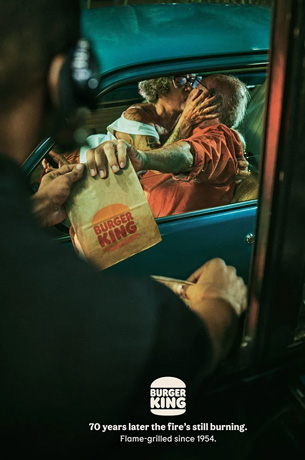Snow on the Roof/Fire in the Furnace – Burger King Advertises Against Agism

In Eastern cultures, older adults are more valued and well-treated than in Western cultures. Easterners have those values thanks to Confucius, the ancient Chinese philosopher whose teaching emphasized having esteem for our ancestors. In contrast, Western culture prizes youth and attractiveness and has mostly negative views about aging and the elderly. Western advertising has often supported this view by featuring primarily the young and the beautiful. More often than not, portrayals of seniors in Western ads align with Clara Peller’s character in Wendy’s famous 1984 campaign, “Where’s The Beef?” Peller plays a stereotypical “old lady” in a dowdy outfit with a crabby attitude.
In light of that reality, it’s refreshing to see Burger King’s new campaign celebrating its 70th anniversary. The company itself has reached elder status among fast food burger chains, having appeared on the scene back in 1954, about the same time as its historic rival, McDonald’s.
As marketing lingo continues to evolve, we seldom talk much any more about the “USP”—the “unique selling proposition.” That term came from one of the true Mad Men in the business, TV advertising pioneer Rosser Reeves, co-founder of the Madison Avenue agency Ted Bates & Company. The USP is the unique benefit that distinguishes your product from its competitors and gives it a competitive edge. Since the beginning, Burger King’s USP has been that their burgers are flame-grilled—cooked over an open flame—for better flavor. (By comparison, McDonald’s burgers are fried on a grill.)
Burger King’s advertising has had a varied career over 70 years. One of its best periods began in 2003 with the hiring of Miami agency Crispin Porter + Bogusky, which created memorable ads featuring the Burger King character, an actor dressed in Renaissance kingly garb and a plastic face frozen in a toothy grin—both humorous and slightly creepy. CS+P’s 2004 “Wake Up With The King” spot opened on a guy waking up in the morning and finding the Burger King in his bed, offering him the new Double Croissandwich. Another TV execution featured a super-sized version of the Burger King character reaching through a high-rise apartment window a la King Kong to hand a burger to a blond woman who resembles Fay Wray. The Crispin Porter creative had just the right amount of wrong. Sadly, when Burger King was bought by 3G Capital, Crispin Porter was told to hit the road and in came McGarry Bowen, who chose to focus on new product ads and target demographics. Their first TV ad pushing BK’s California Whopper scored highly in consumer post surveys, although it beats me why. The ad had a lot of sexy footage of juicy, sliced tomatoes and sizzling bacon, but not a ghost of an idea.
The new Burger King campaign around the company’s significant anniversary is a creative collaboration between their Brazilian agencies Room 23 and Trans Company. In TV and print executions, we see senior couples, well… how I can say this tastefully… making out. And it is tasteful. You might think the sight of septuagenarians sucking face would be off-putting, but there’s something really refreshing about the frankness of these ads. A senior couple, mouth-to-mouth, eating the same french fry. A senior man licking ketchup from the corner of his beloved’s mouth.
In one of the print ads, shot by fashion photographer Guy Aroch, we see a senior couple from behind as they walk across a Burger King parking lot. It’s twilight, and old-growth palm trees sway romantically in the background. The senior man holds a BK take-out bag. With her left hand, the woman is giving the man’s buns a meaty squeeze. At 70, for both the couple and the brand, the fire is still there. The ad bears only two lines of copy. Beneath the logo, it reads, “70 years later the fire’s still burning.” Under that, it says, “Flame grilled since 1954.”
True story: I usually hate anniversary campaigns. They’re almost always self-congratulatory—like marketing that should have been coded for internal viewing only. But remarkably, Room 23 and Trans Company have side-stepped that pitfall. In a stroke of brilliance, they have reinterpreted Burger King’s 70-year-old flame-broiled USP and made it something new.
Will this start a new trend in Western advertising—where we see seniors, not as the “Where’s the beef?” comic relief, but in more meaningful roles that remind us it’s still possible to have a passion for life at age 70? We can only hope.

The Misuse of A/B Testing – My Personal Beef
Most people who have been around marketing long enough have had a brush with A/B Testing (also known as “split

What It Takes To Make ‘Great’
Among the more than 1.5 million species in the animal kingdom, the camel is one of the strangest. You could

Real or Artificial: A Taste of Artificial Intelligence
In 1974, the U.S. Food and Drug Administration approved for consumer use a substance that many thought would be a
